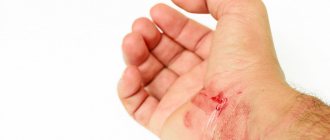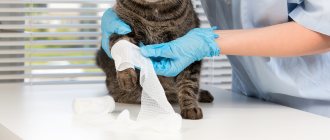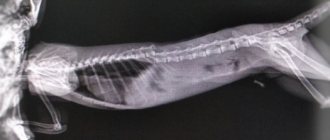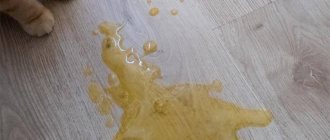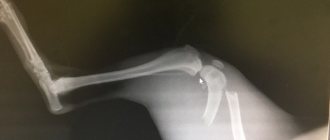May 14, 2020
One of the common reasons for pet owners to visit a veterinarian is when their pet falls from a window or from the balcony of their home.
The reason why cats fall from heights so often can be attributed to several factors. The first and perhaps most important is the carelessness of cat owners and misconceptions about feline behavior in general. Many people transfer their way of thinking to their pets and believe that they are fully aware of the dangers of certain actions and their possible consequences, so they cannot jump down from a window or simply fall. The idea of cats' agility does them a disservice because often their owners think that a pet simply cannot fall by tripping or miscalculating the height. In addition, the belief that cats always land on four paws lulls the vigilance of people who believe that even if the animal loses its balance, it will still land safely and remain unharmed.
Indeed, repeated experiments have revealed the reflexive ability of cats to take the desired position in the air to land on four paws, but this ability does not always save them from injury when falling. Not all cats are able to correctly orient their bodies in flight: kittens have not yet developed the appropriate reflexes; Severely obese cats are not very maneuverable in the air.
In addition, there are individual characteristics - not all animals have reflexes that work as they should. If a cat falls by accident, then it may simply not have time to orient itself and turn around in flight, and if it falls from a great height, the force of the impact will be enormous, and, regardless of what part of the body the animal lands on, it will receive serious injuries.
Symptoms of a cat falling from a height
Fractures and bruises
A bone fracture is associated with a complete or partial violation of its integrity. The main symptoms include pain, bone mobility, and dysfunction of the injured body part. The pain, very severe at the time of injury, becomes dull over time and may disappear when the animal is motionless.
The most striking manifestation of a fracture will be impaired mobility of the affected part of the body or limb: the cat will not be able to lean on the injured paw or chew food with the help of a broken jaw. The exception would be cases where a complete fracture has not occurred, but only a crack or other minor damage to the bone: in such a situation, the animal may not show any discomfort.
In the area of the fracture, the contours, size and shape of the broken bone may change, and even shortening of the limb may be observed. Such deformities can also occur with bruises, so it is important to fully examine the cat.
The main signs of a bruise will be pain, swelling, bruising and disruption of the functioning of the corresponding organ. Immediately after a bruise, dark purple bruises appear on the skin, resulting from ruptures of small vessels. Subsequently, the color of the damaged area will change to green, brown, and then yellow. Due to the release of blood and lymph from ruptured vessels and their pressure on surrounding tissues, pain and swelling appear, varying in intensity.
A bruise may also be accompanied by changes in the functioning of the damaged organ: lameness if a muscle is injured, sometimes paresis and paralysis if a nerve is damaged.
As a rule, a bruise does not affect the general condition of the cat, with the exception of extensive injuries.
Bleeding
Bleeding can occur either immediately after injury or over time. Blood from a damaged vessel can flow both into the external environment and into the animal’s body.
If an artery is damaged, bright scarlet blood gushes out of the wound like a fountain; with venous bleeding, cherry-colored blood flows in a thick stream; blood dripping from the wound is a sign of capillary damage.
Internal bleeding is the most difficult to recognize, since its source is not visible, but it can be suspected by pale mucous membranes, shortness of breath, and increased abdominal volume.
Traumatic brain injuries
Symptoms accompanying a head injury can be varied depending on its nature, the location of the damaged area of the brain, and the general condition of the animal.
With the mildest of injuries - a concussion - only a short-term loss of consciousness occurs; contusion of the brain and rupture of its tissues may be accompanied by stupor and coma. The following signs will indicate brain damage: changes in pupil size (both dilation and constriction), changes in breathing rate or its disappearance, abnormal heart rhythm, unnatural position of body parts.
Much depends on the extent of damage
The first step is to assess the extent of the damage. If a cat falls from a height not exceeding the 5th floor, it can suffer minimal damage. Especially if she landed in a snowdrift, on a bush or grass. However, falling to the ground from a greater height will almost certainly require veterinary intervention.
What can happen: fracture of the spine and limbs, bleeding in internal organs, head injury and even a concussion.
How to understand the extent of damage yourself? If the paws hang motionless, this indicates severe bruises or fractures. If internal organs are damaged, there is usually bleeding from the nose, mouth or intestines, the abdomen increases in size and looks unnatural. If bones fall out or become bent, and touching becomes unbearable, this indicates the presence of fractures. In this situation, you need to urgently contact a veterinarian.
Note! Transporting a cat after a fall can be incredibly stressful and exacerbate existing problems. Therefore, it is recommended to call a veterinarian at home! The cat may also resist being touched or picked up. Be careful not to accidentally make your pet's already difficult situation worse.
Be careful not to accidentally make your pet's already difficult situation worse.
Lay your cat down after a fall without changing its body position
In any case, it may be necessary to move the cat home from the street. Under the influence of emotions, owners often make the mistake of approaching and abruptly trying to take the injured animal. The correct approach requires precision. Try to fix your head so that the cat, due to the shock it has suffered, does not instinctively bite you. Then you need to carefully place your hand, thick cloth or, ideally, a board under it. The main principle is to minimize changes in the cat's body position.
Stop the bleeding properly
Provide assistance to the best of your ability: stop the bleeding, measure the pulse and the number of respiratory movements. If, due to loss of consciousness, the animal has stopped breathing, perform artificial respiration.
The principles of assistance with bleeding are as follows:
- Apply a tourniquet, press the dressing material to the wound - a handkerchief, napkin or something similar.
- Loosen the tourniquet for a minute every hour. Then irreversible changes will not happen.
- To stop blood flowing from the veins and capillaries, a bandage is enough, but for arterial bleeding you need a tourniquet. If the blood is dark in color, this is a sign of arterial bleeding, which quickly leads to a deterioration in the cat's condition.
- If blood flows from the anus, genitals, mouth or nose, you need to immobilize the cat and apply a cold object to the corresponding area. Most often - to the head or stomach, if internal organs are injured.
Actions for vomiting and fractures: how not to worsen the situation
The correct actions of the owners before the veterinarian arrives at the house can be half the successful outcome of such an unpleasant situation as a cat falling out of a window. Let's look at a few more secrets:
Please note that your cat may choke on vomit. To prevent this from happening. you need to keep your head on the side. For fractures of the limbs, a splint should be applied (this does not eliminate the need to treat the wounds), but for fractures of the pelvis or spine, an ineptly applied splint can cause harm, so let a professional do this. Cold compresses and analgin are quite suitable as a pain reliever for a fall. In such a situation, you should not bother, water or force feed the cat.
She should be left alone, carefully laid on her side. Later, you can give small portions of food that is easily digestible
Sometimes there are no visible injuries, but you need to be examined by a veterinarian, as some may not be noticeable to the naked eye, but will appear later. Pay attention to how the temperature changes, the rhythm of breathing, how the process of urination occurs, and so on
First aid for a cat falling from a height
When you find a cat that has fallen from a height, it is important to remember that after the fall it is most likely in a state of shock and can show aggression even towards a person you know well, so it is important to take care of your safety: if possible, wrap your hands in some kind of cloth, protect your face and neck.
If it is not possible to immediately go to a veterinary clinic, the cat must be moved to a warm, quiet place and provided with peace. When transporting an animal, you need to limit its mobility as much as possible; it is best to place the cat on a hard, flat surface (for example, on a board or piece of cardboard); it’s good if you can tie the animal to prevent it from moving, you can use adhesive tape. It is better to place the cat on its side so that, in case of vomiting, the vomit does not enter the respiratory system.
If the cat is bleeding heavily, a pressure bandage should be applied in its place; if the blood is gushing out like a fountain, a tourniquet can be applied above the site of the ruptured vessel. It is important to remember that it is not advisable to keep the tourniquet for more than 1.5 hours in the warm season and 1 hour in the cold season.
You should not give your cat any medications - using them without special knowledge can only harm the animal. And, of course, it is necessary to take the cat to a veterinary clinic as soon as possible, even in the absence of visible injuries - only a veterinarian can assess the cat’s condition and the presence of invisible consequences of injury, such as a ruptured bladder, pneumothorax, pulmonary edema, etc.
How to prevent such a situation?
Will you now be afraid to bathe your cat? This conclusion is incorrect. The correct conclusion would be this: if your cat has contraindications to bathing (weak heart, excessive nervous excitability, aggression when in contact with water, etc.), it should be cleaned with dry shampoo without water.
Or if you are not confident in your abilities that you can bathe the cat without consequences for its health, take a partner, but do not leave him alone with the pet: who knows what can happen between them in your absence? This is not a rhetorical question, there are simply times when the cat is hit by those we trusted. Then, of course, they don’t admit it, and we just wonder what could have happened.
However, you need to understand that most cases when the owner believes that his cat died precisely because of bathing is just a coincidence.
Diagnostic methods in the clinic
What will need to be done to diagnose the cat's condition at the veterinary clinic will depend on the severity and nature of the injuries.
The veterinarian will examine the animal, measure basic vital signs, assess the patient’s general condition, and whether the pet’s life is currently in danger. In any case, even in the absence of visible injuries, an X-ray examination will be necessary: it will help assess the condition of the bones and respiratory system (presence of pneumothorax, pulmonary edema, etc.).
Ultrasound examination (ultrasound) is also performed to assess the condition of internal organs. Further diagnosis will depend on the presence, nature and severity of specific injuries.
Consequences of a cat falling from a height
Shock
Traumatic shock is a complex reaction of the body to damage, accompanied by depression of the nervous system and all vital functions. It is observed in most patients after a fall from a height and is a life-threatening condition.
Shock develops in response to damage to soft tissues and blood loss: the flow of pain impulses entering the cerebral cortex causes its depletion and inhibition that is prohibitive in its strength.
In a state of shock, the cat first becomes extremely excited, then, on the contrary, depressed, not responding to external stimuli, its muscles are relaxed, it cannot fully move, the temperature is low, the pulse is weak, the mucous membranes are pale.
Treatment will be aimed primarily at stopping the flow of pain impulses into the central nervous system and protecting it from further damage. Sleeping pills and narcotics, blockades, drugs that tonic the cardiovascular system can be used, infusion therapy is carried out, and, if necessary, blood transfusions.
Pneumothorax
After a fall as a result of injury, a cat may develop a pathological condition caused by the accumulation of air in the chest cavity - pneumothorax.
The collapse of lung tissue, compression of blood vessels, and displacement of structures located in the chest cavity that occurs under the influence of this condition can lead to death. With pneumothorax, signs of respiratory failure are observed: difficult or absent breathing, pallor or cyanosis of the mucous membranes.
In such conditions, as a rule, air is removed from the chest cavity, after which the patient is given oxygen therapy.
Fracture of the spine, pelvis, limbs, jaw
Most often, falls from a height cause fractures of the front and rear limbs. How severe the consequences of such an injury will be is determined by the nature of the fracture: the degree of displacement of bone fragments relative to each other, the presence and number of fragments, etc.
Treatment is almost always carried out by osteosynthesis, with the exception of fractures of the small bones of the fingers - they are often treated conservatively by limiting mobility.
A spinal fracture is dangerous primarily due to damage to the spinal cord. When it ruptures, the conduction of nerve impulses from the brain to the body is disrupted, which can lead to the death of the cat or its disability.
Trauma in pets can cause pelvic fractures. It is accompanied by lameness of one or two hind limbs, the cat may not even rest on its hind legs at all, and severe pain in the sacrum area.
The method of treatment depends on the location of the fracture site and the presence of damage to organs located inside the pelvic cavity. Treatment can be either conservative or surgical
A jaw fracture in a cat is dangerous because the animal cannot eat properly; in addition, vital structures are located nearby: the respiratory system, brain, etc. This type of fracture can also be treated with surgery.
Cleft palate
As a result of a fall from a height, a hole of various sizes can form in the hard palate. The severity of this pathology will be determined by whether the oral and nasal cavities communicate as a result of the rupture.
If this happens, then the entry of food particles into the nasal cavity and, accordingly, the respiratory system will cause deadly aspiration pneumonia. In such cases, the only possible way to save the cat is surgery, which must be performed as soon as possible. If the resulting rupture is not that serious, then treatment may not be required.
Rupture and bleeding of internal organs
After a cat falls from a height, ruptures of the abdominal organs often occur: most often the spleen or liver are ruptured, which leads to severe internal bleeding, as well as the bladder, which entails urinary peritonitis, which occurs due to urine entering the abdominal cavity.
Most often, such conditions require immediate surgical treatment, otherwise the cat's death is likely.
Traumatic brain injuries
A cat falling from a height is one of the most common causes of this type of injury. Traumatic brain injuries are very diverse in nature and clinical manifestations, and can cause severe and life-threatening conditions.
Brain damage can occur at different levels, both immediately after injury and over time due to a series of chemical reactions in the animal's body. Immediately after a cat falls from a height, primary brain damage may occur as a result of exposure to the damaging factor itself.
The mildest of these will be a concussion, in which there is no damage to brain tissue. A more serious injury would be a brain contusion - it leads to parenchymal bleeding and edema.
Brain rupture - the most severe consequence of injury - is accompanied by damage to brain tissue, as a result of which hematomas appear in the parenchyma and the spaces surrounding it, compressing nerve fibers, which leads to disruption of their functioning and neurological dysfunction.
After an injury, in the absence of timely assistance, secondary brain damage may occur. The factors that cause them will be low pressure, lack of oxygen, depletion of energy reserves, exchange of microelements and organic compounds, which occurs as a response of the body to tissue damage, etc. To prevent such a scenario, appropriate therapy is carried out aimed at saturating tissues with oxygen, supplying the body with the necessary solutions, and treating increased intracranial pressure. At the same time, the patient's neurological status is constantly monitored.
What to do if your cat walks past the litter box
If a cat shits near the litter box, the first thing the owner needs to do is try to completely rid the toilet area of the previous odors and litter particles. “Starting life with a clean slate” is useful if the tray was previously very dirty, or another animal defecated there.
Why does a kitten's whiskers break: the main reasons and what to do
In other cases, it is recommended to pay attention to the health of the pet.
Veterinarian appointment
An inspection is advisable if no obvious problems have been identified in the home. First of all, the animal is diagnosed for diseases of the genitourinary system, and old cats are diagnosed for signs of arthritis or dementia.
First, a general examination is performed: checking the condition of the mucous membranes, searching for discharge, palpating the abdomen. If there are signs of illness, blood, urine and feces are taken for analysis. An ultrasound may also be needed.
Attention! When diseases are detected, the cat is prescribed medication and diet. Inflammatory processes in the non-chronic stage are easily treatable.
Cleaning the tray
Feces must be removed immediately after the cat has gone to the toilet. Areas of the filler wetted with urine - once a day. The filler must be completely changed every 3 days.
At the same frequency, you need to wash the tray with cleaning products - they should not be aggressive. Dishwashing liquid or shampoo will do. If no positive changes are observed, it makes sense to purchase a new tray and thoroughly wash the place where the old one previously stood.
Castration of a cat
Castration of a pet makes life much easier for owners. An unneutered cat or a cat in heat may consciously refuse to pee in the litter box. During this difficult period, females begin to scream heart-rendingly, and males try to mark the territory with their secretions. It is easy to identify such a “mark” - it is a vertical trace from the jet.
There are various veterinary drugs that relieve symptoms, but the most humane option is sterilization. Healthy cats easily tolerate this operation and return to their normal lifestyle within 7-10 days.
For reference: during castration, the male's testicles are removed. As a result, the level of testosterone in his body drops significantly and the need to mark territory with urine disappears.
The right place for the tray
Some recommendations for choosing the location of the cat litter box:
- Place the tray away from where the cat eats. This rule also applies in the opposite direction - if you place food where the cat gets into the habit of going to the toilet, it can be weaned from this habit.
- Do not place the container in a damp place - basement, dressing room, etc.
- Avoid having equipment nearby.
Important! If several animals live in the house (especially both females and males), install trays in different rooms.
For a cat, the litter box is a place of privacy. To prevent her from experiencing stress, the tray should be installed in a remote, enclosed area.
Correct filler
Nowadays you can find any type of filler on sale. They differ in raw materials, granule size, softness, and degree of absorption. The litter must be covered in a thick layer: 7-10 cm. Types of cat litter:
- woody;
- clumping;
- clay;
- silica gel;
- mineral.
It is recommended to choose products with medium-sized granules and odorless. If the cat is accustomed to the type of litter, you should not change it to a new one. For example, replacing wood with silica gel.
Types of fillers
Pets that have started going to the toilet past the litter box can easily be re-educated. Most often, this bad habit is associated with the cat’s discomfort: moving, the appearance of a new family member, competition with another animal. Things are different if the cause lies in the disease. Obvious symptoms of diseases of the genitourinary system appear only in the later stages. Therefore, if there is a change in your cat's behavior, it is recommended that you first take it to the veterinarian.
Prevention
Of the entire list of animal life-threatening conditions encountered by veterinarians, cats falling from a height are distinguished by the ease of preventing such an accident.
To prevent such an incident, it is enough not to let the cat go for a walk on the open balcony and make sure that the windows are closed. Unfortunately, the ventilation mode is no less dangerous for cats: getting a pet stuck between the frames can lead to numerous injuries and often death.
All cat owners are recommended to install special metal mesh on their windows - only they can support the weight of the cat if he wants to go outside. Balconies and loggias must be glazed or cats must not be allowed onto them. If your pet is careless and may fall, for example, from a high cabinet, it is better to limit the cat’s access there.
It is important to remember that the hunting instinct can always be stronger than caution, and previous bad experiences rarely affect cats, so the fact that a cat has already fallen from a window, unfortunately, will not stop it next time, so you should never let your guard down; The best prevention is a responsible attitude towards the animal.
Back
Absolutely forbidden
There are a number of actions that can greatly harm a cat after a fall and negate all future efforts of doctors to save the cat.
- Apply splints and bandages for spinal injuries. This can lead to dangerous displacement of the bones, leading to irreversible consequences.
- Try to bring the cat to consciousness by shaking and shaking your pet, kissing her and hugging her to you.
- You should not forcefully try to feed or water your furry friend.
If outwardly there are no wounds, injuries, or injuries, then it is worth closely observing your pet for several days. If her behavior has not changed, she has not become lethargic, apathetic or aggressive, she still eats as well as before the fall, and copes with her needs normally, then there is no particular reason for concern. Except that the owners need to think about how to prevent the danger of falling for their pet.
If changes are observed in the behavior, habits, or mood of the animal, consultation with a veterinarian is simply necessary. You may need to do an X-ray and ultrasound of the cat so as not to miss serious injuries and complications after them.

